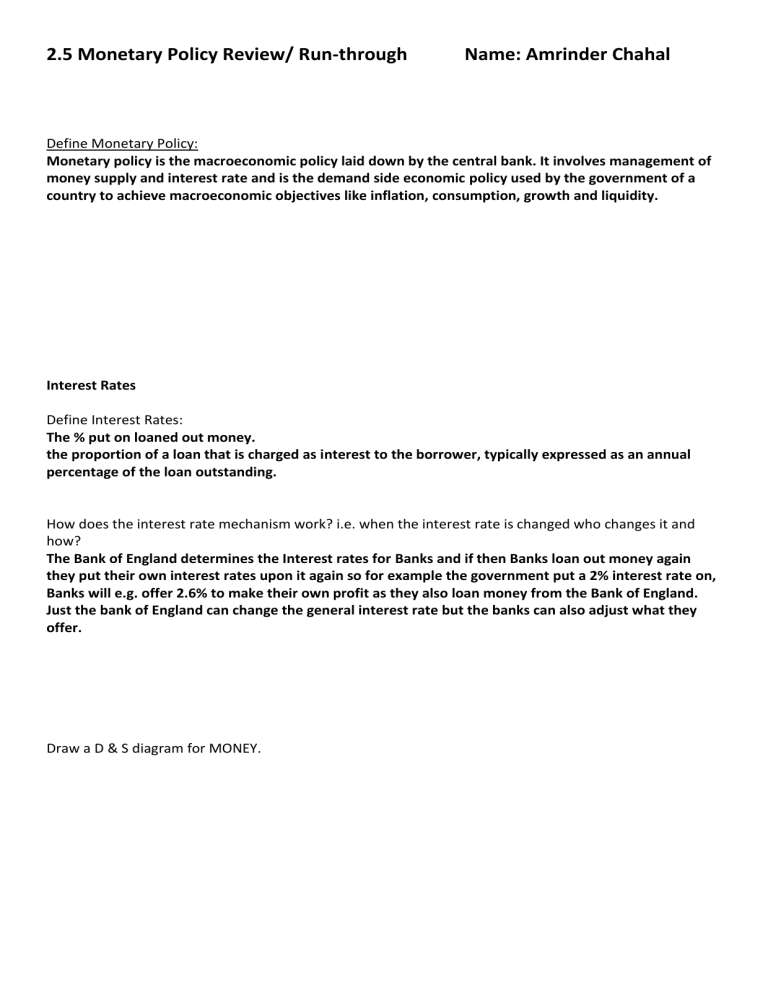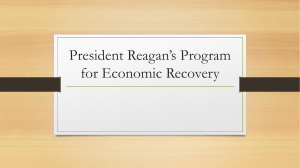
2.5 Monetary Policy Review/ Run-through Name: Amrinder Chahal Define Monetary Policy: Monetary policy is the macroeconomic policy laid down by the central bank. It involves management of money supply and interest rate and is the demand side economic policy used by the government of a country to achieve macroeconomic objectives like inflation, consumption, growth and liquidity. Interest Rates Define Interest Rates: The % put on loaned out money. the proportion of a loan that is charged as interest to the borrower, typically expressed as an annual percentage of the loan outstanding. How does the interest rate mechanism work? i.e. when the interest rate is changed who changes it and how? The Bank of England determines the Interest rates for Banks and if then Banks loan out money again they put their own interest rates upon it again so for example the government put a 2% interest rate on, Banks will e.g. offer 2.6% to make their own profit as they also loan money from the Bank of England. Just the bank of England can change the general interest rate but the banks can also adjust what they offer. Draw a D & S diagram for MONEY. Where does interest rate appear/ represent on this diagram? How does the Central Bank (normally) affect this diagram? The interest rates represent the x-axis and the Central Bank effects this diagram by the money supply and the amount of interest rates it charges upon the banks. Central Banks: Name the central bank of your country, the UK and the US of A. Deutsche Bundesbank, Bank of England, The federal reserve Central Bank Roles implementation of monetary policy o Determining Interest rates, o Controlling Money Supply If central banks are independent the government gives them goals that they must manage the MP in order to achieve (which of our 5 Macro goals could they be set?) Stable rate of Inflation, banker to the government o It is responsible for looking after the money received by the Government, for example, o managing its payments, for example, o managers the national debt by banker to the banks – lender of last resort-> lender of last resort regulation of the banking industry Monetary Policy and AD Bonds: Government issues bonds, for people to take bonds AD Formula: C+G+I+X-M Expansionary, or Easy, Monetary Policy Component Consumer AD Spending Expansionary Go up Government Investment Spending Go up Go up Exports Imports Go down Or go up as with lower interest rates currency Go up Why? e.g. if people need to spend less on interest rates they can spend it elsewhere. Quantity of easing -> buying bond. Helps liquidity. depreciates> goods get cheaper-> more exports E.g. capital People are investment - going to put > cheaper -> their money more or in banks in bigger other investments countries with higher interest rates on their money As with more money to spend people could import more Draw diagrams here for Expansionary, or Easy Monetary Policy. Increasing money supply by lowering interest rates Why is the shape of the AS curve important again? !! Contradictory, or Tight, Monetary Policy. Decreasing money supply to prevent inflation by e.g. increasing Interest rates Component Consumer AD spending Expansionary Goes down Why? Government Investment Spending Goes down Goes down Exports Imports Goes down Goes up Draw diagrams here for Contradictory, or Tight Monetary Policy. Why is the shape of the AS curve important again? !! Monetary Policy and Inflation Targeting. Read this – also on Firefly. http://www.bankofengland.co.uk/monetarypolicy/Documents/pdf/chancellorletter080317.pdf Who is the letter to? And what do they do? To Mark Carney, governor of Bank of England Who is it from? And what does he do? HM treasury and he is the chancellor of the exchequer. Does the Bank of England have an explicit or an implicit target to aim for? What is it? Is the Bank of England Considered Independent? Which of the 5 Goals does the BofE Focus on? Which of the 5 goals does the Bank of England not interest itself in? Can you see a problem? Evaluate the effectiveness of monetary policy through consideration of factors including the independence of the central bank, the ability to adjust interest rates incrementally, the ability to implement changes in interest rates relatively quickly, time lags, limited effectiveness in increasing aggregate demand if the economy is in deep recession and conflict among government economic objectives. Mind map these issues that we have considered here.







